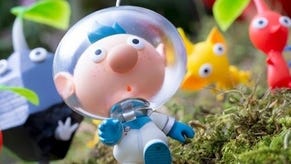New Play Control! Pikmin 2
Old Game Still Better!
Two, you now have two spacemen on the ground, Olimar and Louie, who can be switched between at will in single-player. Each can command a separate Pikmin squad, which makes multi-tasking considerably easier than it was in the first game, a boon when things gets busy. Louie's presence also paves the way for the game's two multiplayer modes, Battle and Challenge (the latter needs to be unlocked in the single-player campaign).
Other than that, you get two new flavours of Pikmin: the chunky purple sprouts, who land with an earth-shaking thud and have the strength (and weight) of ten plant-men; and the sickly, eerie-looking white Pikmin, who can withstand poison and dig up hidden treasures. Cultivation of these types is limited, since they can't be grown from raw materials, only converted five at a time in certain flowers, which adds an interesting new dynamic to population management. With some small adjustments to the abilities of the original red, yellow and blue trio, the new Pikmin open out the game without overwhelming you with choice or disturbing its fine balance.
None of the above is what really makes Pikmin 2 outshine its predecessor, however. More important is the increased density and length of the game, with some 200 items to find versus Pikmin's 30. More important still is the way much of this abundance of content is delivered: in dungeon crawls.
When your game is already an unclassifiable blend of RTS and action-adventure, throwing in the level-plumbing, loot, and no-turning-back risk and reward of a dungeon-crawling RPG is either genius or madness. I'm going with the former. Pikmin 2's caves suspend the passage of the time, allow only a finite number of Pikmin (you can choose how many, but whatever you lose can't be replaced until you emerge), and descend through a series of one-way levels before culminating in a boss fight.
They're a total success, giving the Pikmin template more variety, greater focus, more condensed and crafted level design, more shiny rewards, and restoring a sense of urgency without introducing the stressful constraints of the first game. They heighten that weird microcosmic atmosphere too, with the lilting tunes of above ground taking a turn for moody radiophonic experiments below.

Finally, they make for a neat competitive/co-operative two-player mode in Challenge as you seek to complete caves in the fastest time, losing the least Pikmin, working with and against a friend. Battle mode isn't quite as fun - the race to move marbles to bases works well enough as a design, but it's a forced attempt at softening the brutal dynamics of competitive RTS for Pikmin's family-friendly world. It doesn't sit right. Both modes suffer from tight split-screen presentation too, which can be awkward when tracking large crowds of scurrying Pikmin.
They're not to be sneezed at, all the same, and contribute more than a little to Pikmin 2 being a delight to rediscover. It's expansive, compulsive and overloaded with thoughtful and beguiling details, from Olimar's encyclopaedic log entries on every specimen and artefact in the world to the game's insane menagerie of tactically interesting enemies.
It's so good, there's been no need to change it. As well as the pointer works, it's probably not justification enough of this reissue for Pikmin 2 veterans who still own their GameCube copies. For those who've never experienced this true original, however, or for those who want to be reunited with it, New Play Control! Pikmin 2 comes highly recommended.


